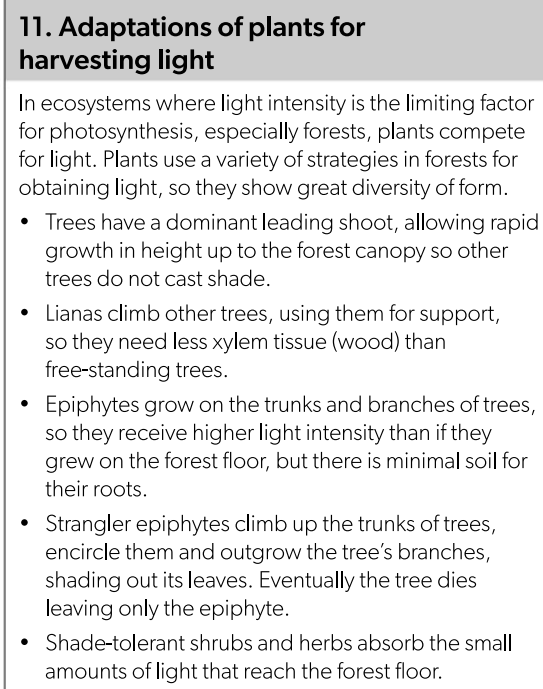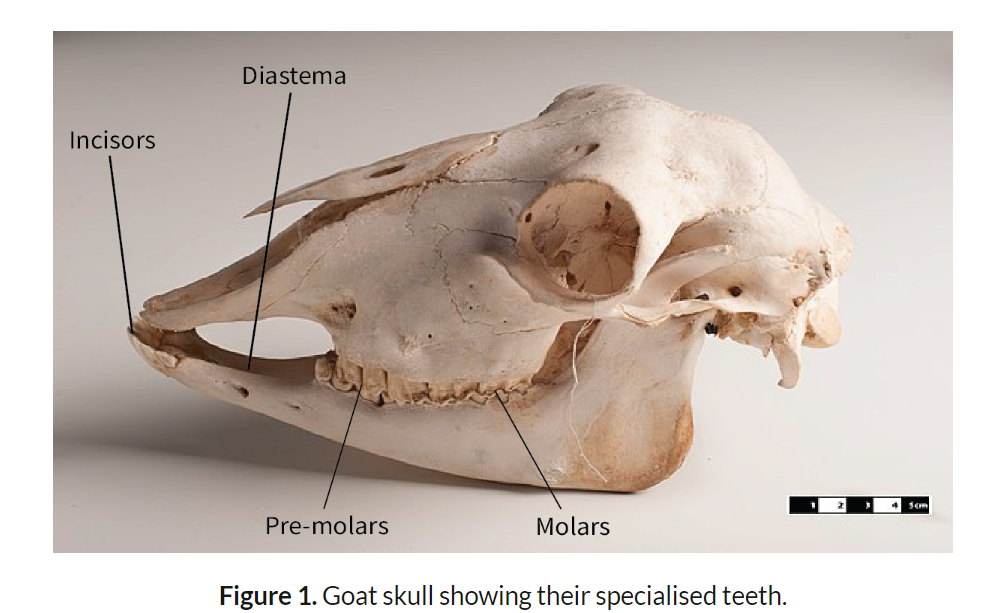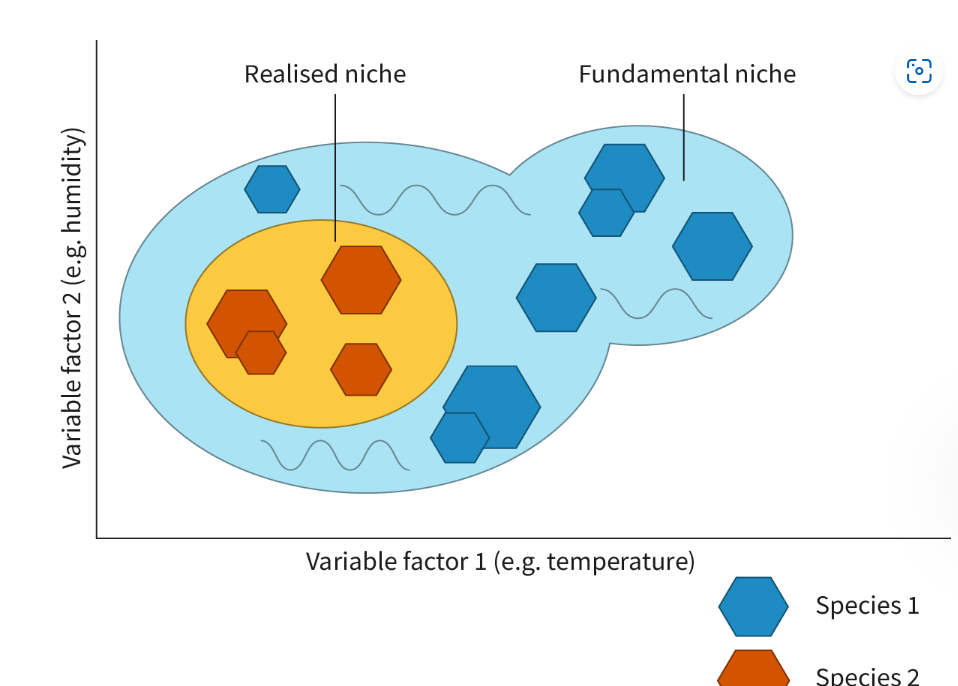B4.2 Ecological niches
1/37
There's no tags or description
Looks like no tags are added yet.
Name | Mastery | Learn | Test | Matching | Spaced |
|---|
No study sessions yet.
38 Terms
State factors that determine the niche of a species.
Food Sources: The type of food a species consumes and how it obtains it.
Habitat: The specific environment or area where a species lives.
Behavior: The species' patterns of activity, such as feeding, mating, and migration.
Interactions: Relationships with other species, including competition, predation, and symbiosis.
Physical Conditions: Abiotic factors like temperature, humidity, and light availability that the species can tolerate.
(Mixture of biotic and abiotic factors)
Obligate Anaerobes
microorganisms/unicellular organisms. Single-celled organisms that cannot survive or grow in the presence of oxygen
→ oxygen is toxic to them
→ obtain their energy through anaerobic respiration or fermentation processes
→ Clostridium botulinum
Facultative anaerobes
→ microorganisms/ unicellular organisms/ single-celled organisms that can survive and grow in the presence or absence of oxygen[
→ can switch between aerobic respiration (using oxygen if available) and anaerobic respiration or fermentation (when oxygen is scarce)
→ Escherichia coli
Obligate anaerobes
→ organisms that require oxygen for their growth and survival[1]
→ rely on aerobic respiration
→ can use sulphates as an electron acceptor
→ Humans
Compare obligate aerobes, anaerobes and facultative anaerobes

State the energy and carbon sources utilized in photosynthesis
Energy from sunlight is used for fixing carbon dioxide and making the carbon compounds such as sugar and amino acids
List three groups of photosynthetic autotrophs.
Plants- mosses, ferns, conifers and flowering plants
Eukaryotic algae- seaweed
Cyanobacteria-
What is holozoic nutrition
refers to organisms that take in solid or liquid food internally
Describe holozoic nutrition in animals
II IDAAE
Ingestion- taking the food into the gut
Digestion- breaking large food molecules into smaller molecules
Absorption- transport of digested food across the plasma membrane of epidermis cells and thus into the blood and tissues of the body
Assimilation- using digested foods to synthesize proteins and other macromolecules and thus making them a part of the body’s tissues
Egestion- voiding undigested material from the end of the gut
→ herbivores/primary consumers feed on plant material
→ carnivores/omnivores/secondary consumers OR any other trophic level above secondary consumers feed on animal material
Outline the acquisition of energy and matter by mixotrophic protists.
Mixotrophic protists acquire energy and matter through two main methods:
Photosynthesis: Like autotrophs, they use sunlight to convert carbon dioxide and water into glucose, storing energy and producing oxygen. This allows them to generate their own organic matter.
Heterotrophy: They also ingest organic matter, such as bacteria or other small organisms, like heterotrophs. This provides them with additional energy and nutrients, especially when sunlight is unavailable.
Uses whichever energy source is most readily available
state an example of a mixotrophic protist.
Euglena: Euglena can perform photosynthesis using chloroplasts to convert sunlight into energy, but it can also consume organic matter from its environment when light is insufficient.
Distinguish between obligate and facultative mixotrophs. (not needed but for basic understanding)
Obligate Mixotrophs:
Definition: Must use both autotrophic and heterotrophic modes of nutrition to survive and grow
Often because the food they consume supplies them with a carbon compound that they themselves cannot synthesize. .
Example: Euglena viridis, which relies on both photosynthesis and ingestion of organic matter for energy.
Facultative Mixotrophs:
Definition: Can use either autotrophic or heterotrophic nutrition depending on environmental conditions, but do not require both simultaneously.
Example: Euglena gracilis, which primarily photosynthesizes but can switch to consuming organic matter when light is limited.
Outline the acquisition of energy and matter by saprotrophic organisms.
Feeds on dead organic matter but have cell walls so cannot take it in by endocytosis.
Secretes digestive enzymes into dead organic matter around them and digests it internally
Secretes protease to digest proteins into amino acids (cellulase to digest cellulose into glucose)
E.coli and yeast
Compare location of digestion in saprotrophs and detritivore animals.
energy source is dead leaves/ dead parts of animals
→ dead organic matter is consumed by detritivores and saprotrophs
→ detritivores ingest dead organic matter
→ example of detritivore such as earthworms/ fungi / bacteria
→ saprotrophs secrete enzymes that digest dead organic matter outside their body
→ saprotrophs absorb the products resulting from the breakdown of dead organic matter
Explain why all saprotrophs are decomposers but not all decomposers are saprotrophs.
All saprotrophs are decomposers because they break down dead organic material into simpler substances, recycling nutrients back into the ecosystem.
Not all decomposers are saprotrophs because decomposers like scavengers and detritivores do not break down organic matter externally but instead consume it or digest it internally.
List the three domains of life.
Archea, Bacteria and eukarya
Outline the characteristics of archaea.
Archaea are similar to bacteria in that they are unicellular and have no true nucleus but they have different biochemistry that separates them from the domain of bacteria. They also differ in their cell walls.
Peptidoglycan is the component of bacterial cell walls whereas polysaccharides make up the archaeal cell walls. It is thought that archaea are the most ancient organisms on the planet.
Members of the archaea are those that have an ability to survive in extreme environments. These archaeans have evolved the enzymes needed to allow them to survive these extraordinary conditions. Some can tolerate extreme salt levels and are called
halophile
s
Compare and contrast between chemosynthesis and photosynthesis
Similarities
→ BOTH result in the release of energy /ATP/transfer energy from one form to another
→ BOTH can use the energy released to synthesise glucose/ transfer energy into chemical energy stored in organic compounds
→ BOTH use inorganic molecules as substrates OR use carbon dioxide as a substrate
→ BOTH can be carried out by bacteria[1]
→ BOTH processes are carried out by autotrophs[1]
Differences
→ chemosynthesis uses the energy from the oxidation of inorganic compounds WHEREAS photosynthesis uses energy from light to excite electrons to release energy
→ photosynthesis requires light to catalyse the reaction WHEREAS chemosynthesis does not
→ photosynthesis produces oxygen WHEREAS chemosynthesis produces sulphide OR nitrogen compounds
→ photosynthesis is carried out by plants, algae and bacteria OR cyanobacteria WHEREAS chemosynthesis is carried out by archaea and bacteria
→ chemosynthesis can take place in extreme conditions, such as near hydrothermal vents under high pressure, WHEREAS photosynthesis cannot
→ photosynthesis requires chlorophyll WHEREAS chemosynthesis does not
Chemoheterotrophs
Energy for ATP production:
Oxidation of carbon compounds obtained from other organisms
Carbon compounds:
Obtained from other organisms not photosynthesis
Photoheterotrophs
Energy for ATP production:
Absorption of lights using pigments (not chlorophyll in archea)
Carbon compounds:
Obtained from other organisms not photosynthesis
Chemoautotrophs
Energy for ATP production:
Oxidation of inorganic chemicals, for example: Fe2+ ions oxidised to Fe3+
Carbon compounds:
Synthesized from carbon dioxide by anabolic reactions
Outline the physiological, morphological and/or behavioral adaptations of mammalian teeth for herbivorous diet
Morphological: Large, flat molars for grinding; reduced canines.
Physiological: Enhanced enamel thickness for durability.
Behavioral: Frequent chewing of fibrous plant material.
Outline the physiological, morphological and/or behavioral adaptations of mammalian teeth for Carnivorous diet
Morphological: Sharp canines and carnassials for tearing meat.
Physiological: Strong jaw muscles for powerful bites.
Behavioral: Rapid, slicing actions to capture and consume prey.
Outline the physiological, morphological and/or behavioural adaptations of mammalian teeth for Omnivorous diet
Morphological: Combination of sharp canines and flat molars.
Physiological: Versatile jaw movement for diverse food types.
Behavioural: Adaptability in chewing and processing both plant and animal matter.
Deduce the diet of an organism given dentition patterns.
Paranthropus robustus- left/herbivores
Homo floresiensis- centre (omnivores/uncooked plants and meets)
Homosapiens- right /omnivores

outline the relationship between dentition, musculature, and diet in herbivorous and omnivorous members of the family Hominidae
herbivorous Hominids consume plants AND omnivorous hominids eat plants and animals
→ example of herbivorous Hominids e.g. gorilla (Gorrila gorrila)
→ have large masseter muscles to grind food
→ have large temporal muscles that allow for forcible bites
→ have larger/broader premolars/molars for grinding plant matter
→ can use their incisors to bite chunks of vegetation
→ herbivorous and omnivorous Hominids can have large canines for social interactions (e.g. fighting or ritual displays)
→ example of omnivorous Hominidae e.g. chimpanzee
→ have relatively smaller masseter muscles
→ have relatively smaller temporal muscles
→ can use canines to grab and tear prey
→ can use incisors to bite chunks from prey[1]
→ have relatively smaller premolars OR molars
Comparison of the adaptation of predators and preys in terms of structural, chemical and behavioural

Outline the physiological, morphological and/or behavioral adaptations of leaf eating insects for feeding on plants.
Physiological:
Proboscis: Long, straw-like mouthparts (e.g., aphids) to access internal fluids.
Mandibles: Strong jaws for cutting and chewing (e.g., beetles).
Morphological:
Stylet: Needle-like structure in aphids for penetrating plant tissues.
Body Structure: Flattened bodies to navigate between plant parts.
Behavioural:
Selective Feeding: Feeding on specific plant parts or species to avoid toxins.
Mimicry: Camouflaging to avoid detection by predators.
They also grow their teeth constantly due to constant grinding which can wear their teeth down .
Outline the physiological, morphological and/or behavioural adaptations of plants for resisting herbivory.
Physiological:
Toxic Compounds: Production of secondary metabolites (e.g., alkaloids, terpenes).
Chemical Defenses: Release of deterrents or toxins when damaged (e.g., milkweed).
Morphological:
Thorns and Spines: Physical barriers (e.g., cacti, thistles).
Trichomes: Microscopic hairs that deter insects (e.g., nettles).
Behavioral:
Chemical Signals: Release of volatile compounds to attract predators of herbivores.
Hiding: Growth forms like Lithops that mimic stones to avoid herbivory.
Outline the chemical, physical and/or behavioral adaptations of predators for finding, catching and killing prey.
Chemical:
Venom: Toxins to paralyze or kill prey (e.g., cone snail venom).
Physical:
Sharp Claws and Teeth: For capturing and killing (e.g., lions, eagles).
Enhanced Senses: Acute vision, smell, or hearing (e.g., owls, moles).
Behavioral:
Cooperative Hunting: Working in groups to capture prey (e.g., dolphins’ mud ring).
Mimicry: Using calls or behaviors to lure prey (e.g., Margay’s distress call mimicry).
Outline the chemical, physical and/or behavioral adaptations of prey animals for resisting predation.
Chemical:
Defensive Sprays: Noxious chemicals to repel predators (e.g., skunks).
Physical:
Camouflage: Blending into the environment (e.g., zebras, chameleons).
Defensive Structures: Spines or shells (e.g., hedgehogs, tortoises).
Behavioral:
Group Behavior: Forming groups to confuse predators (e.g., mackerel schools).
Escape Responses: Quick movement or flight responses (e.g., gazelles).
Describe examples of adaptations for harvesting light, including height, lianas, epiphyte, shade-tolerance, and leaf surface area.
Height:
Tall Growth: Reaching above other plants to access light (e.g., towering rainforest trees).
Lianas:
Climbing: Aerial roots climb tall trees to reach sunlight (e.g., lianas in rainforests).
Epiphytes:
Non-Ground Growth: Growing on other plants to access light (e.g., orchids, bromeliads)
Shade-Tolerance:
Large Leaf Surface Area: To capture more light in low-light environments (e.g., understory plants).
Leaf Modifications:
Broad, Thin Leaves: Increasing surface area to capture light (e.g., many rainforest understory plants).

for understanding- in a diagram of a skull label the incisors, diastema, pre molars and molars

Distinguish between the fundamental and realized niche.
Fundamental Niche: The full potential range of conditions and resources an organism can use.
Realized Niche: The actual conditions and resources used by an organism in the presence of other species.
Fundamental Niche:
Definition: The fundamental niche represents the full range of environmental conditions and resources an organism could theoretically use without the influence of other species. It encompasses all the potential habitats and resources that the species can utilize in the absence of competition, predation, or other biotic factors.
Example: A plant species might have a fundamental niche that includes a wide range of soil types and moisture levels, assuming no other plants are competing for these resources.
Realized Niche:
Definition: The realized niche is the actual niche that a species occupies in the presence of biotic interactions such as competition, predation, and disease. It is often smaller than the fundamental niche because of these interactions.
Example: The same plant species might only be found in specific soil types and moisture levels in a natural ecosystem due to competition with other plant species and limited resources.

Explain competitive exclusion as a factor that can limit the distribution of a species in an ecosystem.
The competitive exclusion principle states that two species cannot coexist indefinitely in the same niche if their niches are identical or very similar. The species that is slightly more efficient at utilizing resources will outcompete the other, leading to the exclusion of the less efficient species.
Explain why two species cannot survive indefinitely in the same habitat if their niches are identical.
Identical niches mean the same resources are required by both species. The species with a slight advantage will use resources more efficiently and outcompete the other.
State that organisms that can adapt to extreme niches encounter less competition and predation.
Less Competition: Organisms adapted to extreme or highly specialized niches encounter less competition because fewer species can thrive under such extreme conditions. For example, extremophiles in high-temperature environments or highly saline conditions face minimal competition.
Predation: Extreme niches often have fewer predators, as specialized predators might not be adapted to these conditions, further reducing competitive pressures on the species adapted to these niches.
Define Niche partitioning
Strategies like spatial and temporal partitioning allow similar species to coexist by utilizing different aspects of the niche.